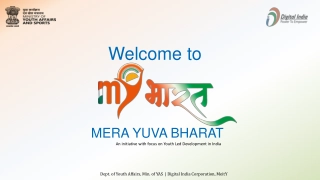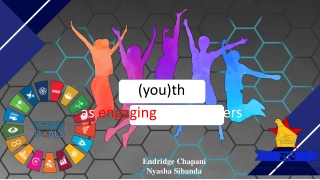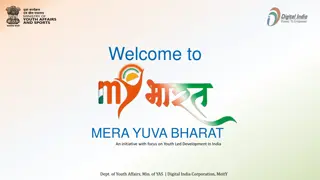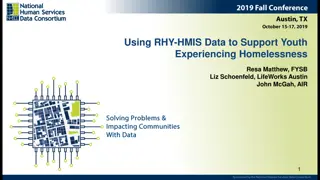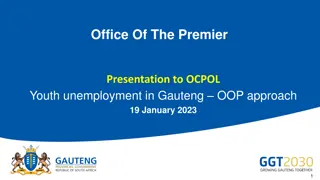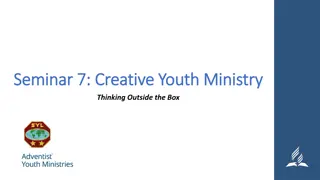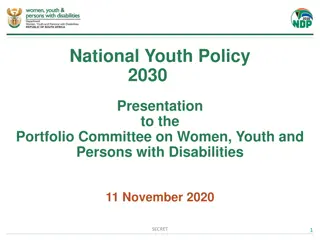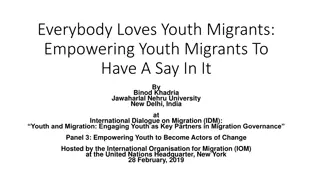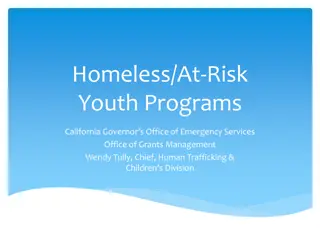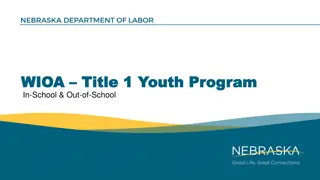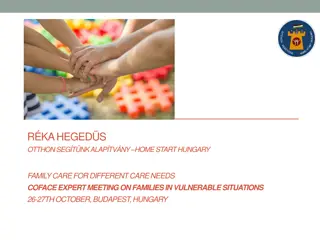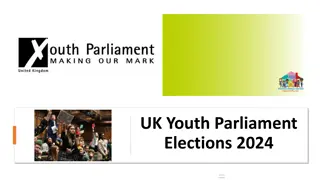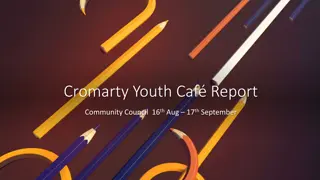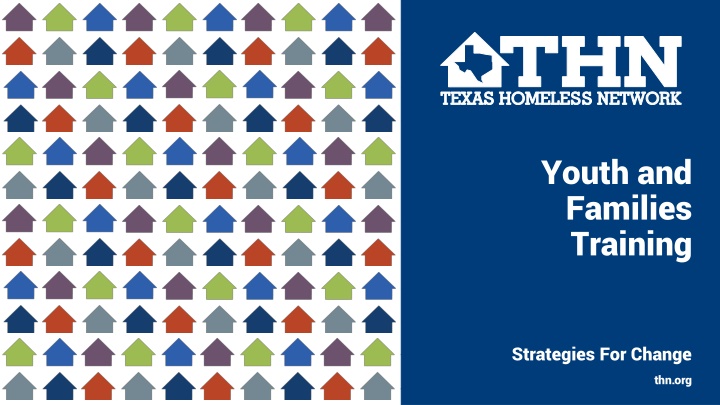
Strategies for Change in Youth and Families Training Programs
Explore modules covering topics like PIT count logistics, differences in homelessness subgroups, and addressing pregnant and parenting youth experiencing homelessness. Understand the interconnectedness of family and youth homelessness and definitions of literal homelessness. Find resources for enhancing existing processes and ensuring accurate youth and family representation in homeless counts.
Download Presentation

Please find below an Image/Link to download the presentation.
The content on the website is provided AS IS for your information and personal use only. It may not be sold, licensed, or shared on other websites without obtaining consent from the author. If you encounter any issues during the download, it is possible that the publisher has removed the file from their server.
You are allowed to download the files provided on this website for personal or commercial use, subject to the condition that they are used lawfully. All files are the property of their respective owners.
The content on the website is provided AS IS for your information and personal use only. It may not be sold, licensed, or shared on other websites without obtaining consent from the author.
E N D
Presentation Transcript
Youth and Families Training Strategies For Change thn.org
Module 1 Module 2 Module 3 Winter PIT Count Date: Module 4 1/23/2025 Module 5 Module 6 Wrap- Up
Module 1 Agenda Module 2 Introduction/ Definitions PIT Count Logistics Differences in Homelessness Subgroups of Homeless Youth Schools as PIT Partners Next Steps Module 3 Module 4 Module 5 Module 6 Wrap- Up
Introduction Module 2 This document compiles feedback from several communities as well as larger efforts. Listed at the end of this document are just a few resources that communities can use to analyze and improve their existing process. Please note that there are comments written on many of the slides to provide additional context and talking points for this presentation. Module 3 Module 4 This tool is not mean to be a comprehensive guide on conducting the Point-in-Time (PIT) count. It is a supplemental resource that was developed specifically to assist with ensuring youth and families are accounted for on the day of the PIT. Module 5 Module 6 If you have questions, concerns, or feedback on the information in this presentation please reach out to the THN Data Coordinator. Wrap- Up
Youth Homelessness is Family Homelessness Module 2 To prevent and end homelessness among youth in America, we must address the unique needs of pregnant and parenting youth who experience homelessness. Otherwise, we risk missing opportunities to ensure that pregnant youth, young parents, and their children have the resources they need to reach their full potential. - School House Connection Module 3 Module 4 Simply put, youth homelessness cannot be solved in isolation from family homelessness, and vice versa. Module 5 Family homelessness is a precursor to youth homelessness, and youth homelessness is a precursor to family homelessness. Module 6 Wrap- Up
Literally Homeless (Definition) Module 2 Individual or family who lacks a fixed, regular, and adequate nighttime residence, meaning: Module 3 (i) Has a primary nighttime residence that is a public or private place not meant for human habitation; Is living in a publicly or privately operated shelter designated to provide temporary living arrangements (including congregate shelters, transitional housing, and hotels and motels paid for by charitable organizations or by federal, state and local government programs); (iii) Is exiting an institution where (s)he has resided for 90 days or less and who resided in an emergency shelter or place not meant for human habitation immediately before entering that institution (ii) Module 4 Module 5 Module 6 Wrap- Up
Homeless Children and Youths (Definition) Module 2 U.S. Department of Education (ED) Subtitle VII-B of the McKinney-Vento Homeless Assistance Act defines homeless children and youths as follows: The term "homeless children and youths" Meaning individuals who lack a fixed, regular, and adequate nighttime residence (within the meaning of section 11302(a)(1) of this title); and includes i. children and youths who are sharing the housing of other persons due to loss of housing, economic hardship, or a similar reason; are living in motels, hotels, trailer parks, or camping grounds due to the lack of alternative adequate accommodations; are living in emergency or transitional shelters; are abandoned in hospitals; or are awaiting foster care placement; ii. children and youths who have a primary nighttime residence that is a public or private place not designed for or ordinarily used as a regular sleeping accommodation for human beings (within the meaning of section 11302(a)(2)(C) of this title); iii. children and youths who are living in cars, parks, public spaces, abandoned buildings, substandard housing, bus or train stations, or similar settings; and iv. migratory children (as such term is defined in section 6399 of title 20) who qualify as homeless for the purposes of this subtitle because the children are living in circumstances described in clauses (i) through (iii). Module 3 Module 4 Module 5 Module 6 Wrap- Up
Unaccompanied Youth (Definition) Module 2 Subtitle VII-B of the McKinney-Vento Homeless Assistance Act defines unaccompanied youth as follows: The term unaccompanied youth includes a youth not in the physical custody of a parent or guardian. Unaccompanied Youth are under the age of 24 Module 3 Module 4 Module 5 Module 6 Wrap- Up
Point-in-Time Count (PIT) Basics Module 2 U.S. Department of Housing and Urban Development (HUD) requires all CoCs to conduct an annual count of individuals residing in: Unsheltered locations (such as cars, streets, parks, etc.) as well as Sheltered locations (Emergency Shelter, Domestic Violence Shelters, and Transitional Housing). Module 3 The PIT Count aims to provide a snapshot of the individuals and families experiencing homelessness in a geographical area, over the course of one night. Each count is planned, coordinated, and carried out locally by service providers and trained volunteers Module 4 Module 5 Module 6 Wrap- Up
Counting Youth During the PIT 1. Have A Strong Leadership Team 2. Get Youth Input Early and Often 3. Partner with the Youth Service Community 4. Designate a Youth PIT Count Coordinator 5. Address the Issue of the Stigma of Homelessness 6. Use Social Media 7. Count in Locations Where Youth Experiencing Homelessness Gather 8. Be Flexible 9. Communicate the Data Module 3 Module 4 Module 5 Module 6 Wrap- Up
Have a Strong Leadership Team A PIT Count is successful only when the entire community is informed, involved, and ready to help. Module 3 A strong leadership team should be ready to overcome barriers, engage relevant community stakeholders, and help facilitate coordination and action locally. Having buy-in from leadership clearly communicates that finding and assisting youth experiencing homelessness is a priority for the community Module 4 Module 5 Module 6 Wrap- Up
Get Youth Input Early and Often Youth are the experts. Communities that want to most accurately count youth, and subsequently serve them, need to have youth at the table beginning with planning and throughout the entire counting experience. Communities have gotten youth input in many different ways. Some communities have found a single champion among their youth who is willing to be a regular participant in counting opportunities, while others have created youth advisory teams. Other communities regularly convene youth focus groups where youth who are currently or formerly experienced homelessness talk about their unique experiences and provide insights about the best times and places to find youth experiencing homelessness. Module 3 Module 4 Module 5 Regular consultation with youth allows communities to develop outreach and training materials that are youth-inclusive, inclusive, and accurately representative of the experiences of homeless youth in the community. Module 6 Wrap- Up
Partner with the Youth Service Community There are many stakeholders involved in providing child and youth services. This includes: schools, youth shelters, drop-in centers, libraries, community centers, afterschool programs, affordable housing developers, youth employment programs, Module 3 faith-based groups, food banks, parks, child welfare workers, juvenile justice workers. Module 4 Module 5 It is particularly important that PIT Leads engage local homeless education liaisons in every phase of the PIT count process. Just as youth need to be at the table as soon as possible, these stakeholders should be included in the PIT count planning process and be regular partners in the PIT count experience. These relationships should extend beyond the PIT count as well, to ensure there is a coordinated effort to find and serve youth all year long. To find your local Liaison: https://www.theotx.org/liaison-directory/ Module 6 Wrap- Up
Designate a Youth PIT Count Coordinator Many communities have designated a single person to coordinate the youth PIT count effort. This person does not need to be a content expert but is organized and cares about the cause. Given all of the coordination involved in conducting a successful count of youth, it is crucial that the community has a person who can keep a clear focus on coordinating partners and can manage the many steps necessary to conduct the count. Some communities have used their general PIT count lead to serve this function, while others have sought a volunteer from among their partners willing to fulfill this role. Interns have been asked to serve in this role as well, but it is important to ensure they have enough support and authority from appropriate agencies to be able to execute count coordination. Module 3 Module 4 Module 5 Module 6 Wrap- Up
Address the Stigma of Homelessness Being identified as homeless creates a stigma that most people including youth are anxious to avoid. Communities have addressed this challenge by minimizing or removing references to homelessness and focusing instead on housing status. For instance, when conducting surveys, rather than volunteers stating that they are conducting homeless surveys, volunteers can ask participants if they would be willing to answer a few questions about their current housing situation. Module 3 Module 4 Additionally, interviewers should be careful to maintain confidentiality and be sensitive to how the survey is administered For instance, when interviews are conducted in a more open setting, interviewers should pay attention to their surroundings and whether others in the area are likely to overhear responses to the surveys. e going to be seen as homeless. Module 5 Module 6 Wrap- Up
Use Social Media Use social media to raise awareness and outreach: Youth living on the streets or other places not meant for human habitation still use social media. Social media can be used to spread the word about the count, including information about location and incentives to participate in the count. Text messaging platforms can also be helpful in spreading the word to them. Module 3 Module 4 Module 5 Module 6 Wrap- Up
Count Where Youth Experiencing Homelessness Gather Possible hot spot locations: Abandoned buildings High traffic urban areas (i.e., nightclubs, tattoo parlors, record stores, arcades) Pizza places, soda shops, etc. near high schools Parks Malls Fast food restaurants LGBTQ friendly gathering spots (school support groups, bookstores, coffee houses identified by LGBTQ service providers and youth) Encampments inside and outside of urban areas Module 3 Module 4 Module 5 Hold magnet events. Develop special events located at easily accessible and non-threatening locations that include activities, food, or other appropriate incentives that might draw in youth who do not typically use shelters and services and are difficult to locate on the streets. Module 6 Use social media to raise awareness and outreach. Wrap- Up
Be Flexible Youth might not be visible on the street during school hours. Survey locations during multiple times throughout the day of the count. Consider assessing count routes prior to the count to ensure that teams are in the right places at the right times. A location that is crowded in the morning might be empty only a few hours later A community may choose to extend the hours of the count into the evening hours to reach during the time between when drop-in programs close for the day and when youth retire for the night. It is absolutely imperative that you do your due diligence to not double count. Ensure that you are always asking if the youth has already been surveyed Include any identifying information they provide to help de-duplicate Module 3 Module 4 Provide services, food, and incentives to youth being counted. The incentive could be advertised as part of the general mobilization effort to attract youth to participate in the count. Examples of incentives include: two-way public transportation tickets, a credit card with $10 credit, a backpack filled with hygiene items/information about services, a $5 restaurant card, bag lunches, and/or providing food, movies, and games, and a warm, dry place to spend time with friends for the night Module 5 Module 6 Wrap- Up
Youth Vs. Adult Homelessness TheRoot Cause of Youth Homelessness tend to be different: Most youth end up on the streets for one reason: family disruption. Youth simply would not be on the streets if they were able to be at home safely. Very few youth are homeless because of their own choosing. Module 4 Homeless Youth Tend to Lack Social Support Networks They ve lost not only their families, but also connections to schools, churches, jobs, and other community resources. Youth tend to require even more social support than an adult exiting homelessness because they are younger and have had less time (and likely, little opportunity) to cultivate emotionalassetslikeself-esteem and perseverance. Module 5 Module 6 The Opportunity to Minimize Long-Term Negative Effects of Homelessness If given access to the proper resources to exit the streets, a youth will likely suffer fewer long-term effects of homelessness than an adult who has been homeless for an extended period of time. Wrap- Up
Counting Youths Vs. Adults Studies have shown that general PIT count methods are less accurate at recording youth homelessness compared to adults. Youth are often disconnected from community services and more likely than adults to be highly transient or hiding in plain sight among their peers. Many homeless youth don t want to be found. They may be fleeing abuse or fear being placed in foster care. Most aren t connected to formal supports such as the child welfare, juvenile justice, and mental health systems. Many avoid or are unaware of available services. Module 4 Module 5 The tactics that you would use to engage single adults is different and this is why it is imperative that you are finding ways to engage youth and youth service providers throughout the entire count process. Develop your plan for engaging youth early and whenever possible, have at least one person dedicated to coordinating youth count processes. Module 6 Wrap- Up
Subgroups of Homeless Youth Sleeping Location Unsheltered Sheltered Doubled Up Household Unaccompanied Youth Youth in families Parenting Youth Type Module 5 Module 6 Risk Factors Aged out of Foster Care LGBTQ+ Runaway Wrap- Up
LGBTQ+ Youth Homelessness is one of the most pressing issues facing a disproportionate number of lesbian, gay, bisexual, transgender, and queer/questioning (LGBTQ) youth in our country today. Service providers also estimate anywhere from 20-40% of youth experiencing homelessness identify as LGBTQ, while only 7-10% of the general youth population identifies as such. Youth homelessness is just as much of a challenge in rural communities as it is in urban communities. Young people in rural communities might be less inclined to identify as LGBTQ or further delay coming out when social norms in those communities are less safe or affirming of such identification. Module 5 Module 6 Citation: True Colors Fund Wrap- Up
Schools as PIT Count Planning Partners Schools can provide valuable insights into and help with Recruiting count volunteers Selecting youth-friendly count sites Creating a welcoming and youth-friendly environment at count sites Selecting youth-friendly incentives for count participation Suggesting other local youth service providers to assist with the count Local liaisons and school personnel may volunteer to administer PIT count surveys if conducted off school premises and during non-work hours Note: For youth that have a parent or guardian identified, you will need to contact their parent and obtain consent in order to fill out the survey. You will need to complete a survey on the entire family, not just the youth. Module 6 Wrap- Up
Recommended Practices for Schools: Information-Sharing Schools can help get the word out about the PIT count by: Posting youth-friendly information about the count throughout schools, including: who the target population is (youth experiencing homelessness under the HUD definition) How/where/when to participate in the count Possible incentives for participation Please ensure that you are informing homeless youth identified as unaccompanied about the count in advance and the possible benefits of participation If you are working with families experiencing homelessness, ensure that you are reaching out to the parent s guardians in advance of the count to inform them of the count date as well as answer any questions they may have about count logistics. Module 6 Wrap- Up
Prohibited Practices for Schools Under the Family Educational Rights and Privacy Act (FERPA), schools may not disclose personally identifiable information about students without the prior written consent of a parent or eligible student (a student who has reached 18 years of age or is attending an institution of postsecondary education) Under the Protection of Pupil Rights Amendment (PPRA), schools may not require students to complete a survey that reveals certain types of personal information without the prior written consent of a parent or eligible student (a student who has reached 18 years of age or is an emancipated minor) as part of a program administered by the U.S. Department of Education Module 6 Wrap- Up
Statutory Guidelines Two key pieces of federal legislation guide how local education agencies (LEAs) and schools may engage in PIT Count planning and implementation: The Protection of Pupil Rights Amendment (PPRA), which addresses the administration of surveys. The Family Educational Rights and Privacy Act (FERPA), which addresses the sharing of personally identifiable information (PII) about students with third parties. These guidelines make the broad and systematic administration of PIT count surveys in schools difficult. Module 6 Wrap- Up
PIT Count Collaboration Awareness-building Schools and LEAs can help spread awareness about the PIT count by: Posting family- and youth-friendly information about the count throughout schools. Coordinating local homeless education liaisons and other school personnel to inform families and youth identified as homeless about the count and the possible benefits of participation. Helping survey families and youth outside of school hours. Helping train general volunteers on best practices for engaging youth and families. Planning School and LEA involvement in PIT count planning provides valuable insights and helps with: Selection of welcoming count sites/providing insight into volunteer shift times Identification of potential hot spots based on your own data Coordinating incentives and resource fairs to increase family and youth participation Providing PIT leads aggregated data of the Youth that fall under the PIT definition of homelessness. (This can be used to inform how many volunteers will be necessary to conduct surveys) Module 6 Wrap- Up
Opportunities to Consider PIT Leads and schools are encouraged to work together to share and leverage their respective data sets by referencing each other s numbers in reports and public talking points, as appropriate, and using multiple sources of data to inform local efforts to serve homeless youth Wrap- Up
Getting Started Review the information provided by the National Center for Homeless Education (NCHE) View PIT Count information on THN s website. Work with your local PIT Lead on ways you can assist with the count while still being mindful of statutory guidelines. Wrap- Up
Resources Housing and School Partnership on the Point-In-Time Count. NCHE Data on Homeless Children and Youth True Colors Fund Youth Count Toolkit Chapin Hall Youth Count Toolkit We Count, California! Youth Count! Process Study Wrap- Up
Contact Information Ava Paredes Data Coordinator Thank you! Email: Ava@THN.org Phone: (512) 652-4714 Strategies For Change thn.org

